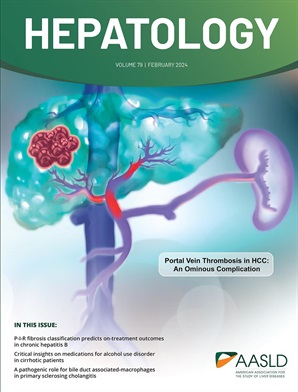原发性胆汁性胆管炎:个性化二线疗法-R1
IF 15.8
1区 医学
Q1 GASTROENTEROLOGY & HEPATOLOGY
引用次数: 0
摘要
原发性胆汁性胆管炎(PBC)是一种神秘的自身免疫性疾病,以小叶内胆管为靶点,导致胆汁淤积,并有可能发展为胆汁性肝硬化。PBC 主要影响中年女性,其诊断通常比较简单,大多数患者会出现胆汁淤积性肝脏检查和高度特异性的抗线粒体抗体。几十年来,治疗 PBC 的基础药物一直是熊去氧胆酸(UDCA),它可以延缓大多数患者的疾病进展,但对 PBC 症状没有影响。对 PBC 患者进行的大型队列研究证实,使用 UDCA 可以最大限度地降低血清碱性磷酸酶,而对于未达到充分反应的患者,则需要添加二线药物。随着对胆汁酸生理学认识的不断深入,开发出了能改善 PBC 患者胆汁淤积状况的新药,并有望降低疾病进展的风险。奥贝胆酸是首个获准用于治疗 PBC 的二线疗法,它能显著改善肝脏生化指标,并能改善长期临床疗效,但因其易诱发瘙痒而受到限制。伊拉布诺和塞拉德帕是最近获准用于 PBC 患者的过氧化物酶体增殖体激活受体激动剂,而贝扎贝特和非诺贝特则是标签外疗法。这两种药物还能改善对 UDCA 反应不足的患者的生化指标,但可能会改善瘙痒症状。在此,我们回顾了在决定是否适用二线药物时应考虑的患者特征,以及考虑使用哪种药物才能真正实现个性化的 PBC 患者护理方法。本文章由计算机程序翻译,如有差异,请以英文原文为准。
Primary Biliary Cholangitis: Personalizing Second-Line Therapies-R1
Primary biliary cholangitis (PBC) is an enigmatic, autoimmune disease targeting the small intralobular bile ducts resulting in cholestasis and potentially progression to biliary cirrhosis. Primarily affecting middle-aged women, the diagnosis of PBC is typically straightforward with most patients presenting with cholestatic liver tests and the highly specific anti-mitochondrial antibody. For decades, the foundational treatment of PBC has been ursodeoxycholic acid (UDCA) which delays disease progression in most patients but has no impact on PBC symptoms. Large cohort studies of patients with PBC have established the benefit of maximizing the reduction in serum alkaline phosphatase with UDCA and the need to add second-line agents in patients who do not achieve an adequate response. Advances in the understanding of bile acid physiology have led to the development of new agents that improve cholestasis in patients with PBC and are predicted to reduce the risk of disease progression. Obeticholic acid, the first second-line therapy to be approved for PBC, significantly improves liver biochemistries and has been associated with improved long term clinical outcomes but is limited by its propensity to induce pruritus. Elafibranor and seladelpar are peroxisome proliferator-activated receptor agonists recently approved for use in patient with PBC, whereas bezafibrate and fenofibrate are available as off-label therapies. They also have shown biochemical improvements among patients with an inadequate response to UDCA, but may improve symptoms of pruritus. Herein, we review the patient features to consider when deciding whether a second-line agent is indicated and which agent to consider for a truly personalized approach to PBC patient care.
求助全文
通过发布文献求助,成功后即可免费获取论文全文。
去求助
来源期刊

Hepatology
医学-胃肠肝病学
CiteScore
27.50
自引率
3.70%
发文量
609
审稿时长
1 months
期刊介绍:
HEPATOLOGY is recognized as the leading publication in the field of liver disease. It features original, peer-reviewed articles covering various aspects of liver structure, function, and disease. The journal's distinguished Editorial Board carefully selects the best articles each month, focusing on topics including immunology, chronic hepatitis, viral hepatitis, cirrhosis, genetic and metabolic liver diseases, liver cancer, and drug metabolism.
 求助内容:
求助内容: 应助结果提醒方式:
应助结果提醒方式:


